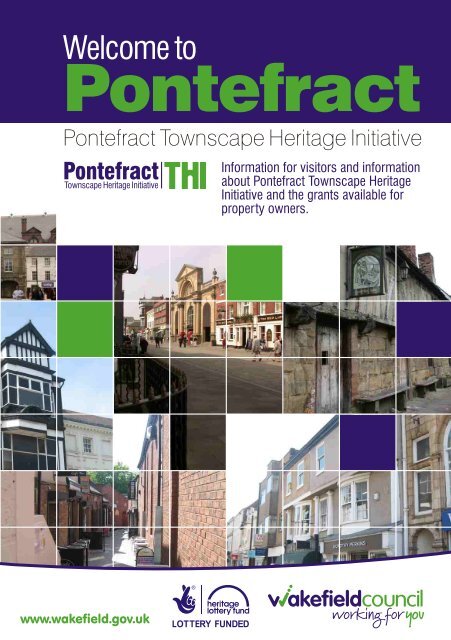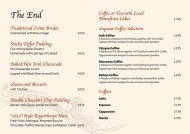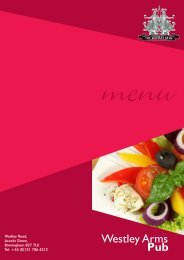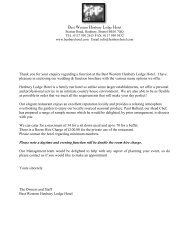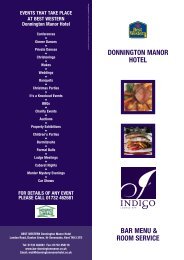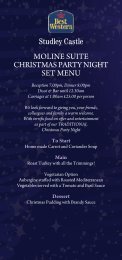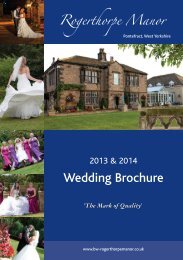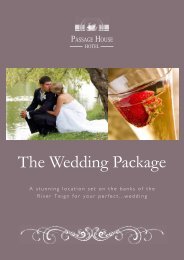Pontefract Visitor Booklet A5 new 2
Pontefract Visitor Booklet A5 new 2
Pontefract Visitor Booklet A5 new 2
- No tags were found...
Create successful ePaper yourself
Turn your PDF publications into a flip-book with our unique Google optimized e-Paper software.
Welcome to<strong>Pontefract</strong><strong>Pontefract</strong> Townscape Heritage Initiative<strong>Pontefract</strong>Townscape Heritage InitiativeInformation for visitors and informationabout <strong>Pontefract</strong> Townscape HeritageInitiative and the grants available forproperty owners.www.wakefield.gov.uk
<strong>Pontefract</strong> Market PlaceWelcome to <strong>Pontefract</strong>, we hope that the following information willhelp you understand some of the town’s rich heritage, and how this inturn has allowed us to successfully secure funding to help protectand renovate key buildings in the town centre to ensure that futuregenerations can enjoy this amazing link to the past.Extract from:The Present State of Great Britain and Ireland. Published, London 1716.<strong>Pontefract</strong>, or Pomfret, is a neat Town, that had formerly a strong and stately Castle,which fell by the Civil Wars in the Reign of King Charles I. 'Twas in this Castle RichardII was barbarously murdered, after his Resignation of the Crown to Henry IV hisCousin.1
Extract from:British Curiosities in Art and Nature. Published,London 1721.<strong>Pontefract</strong> (or Broken Bridge) a Town remarkable:1. For its very pleasant situation2. Neatness of Buildings3. A Stately Castle [and]4. For plenty of LiquorishContents1 <strong>Pontefract</strong> MarketPlace3 <strong>Pontefract</strong>Townscape HeritageInitiative (THI)6 History<strong>Pontefract</strong> Town Centre is a real gem, agreat mix of buildings all within a verysmall area, dating from medieval timesthrough to the late 20th Century. Somebuildings sit harmoniously with theirneighbours whilst others show the realcontrast of building materials and styles-It is indeed a neat town in a pleasantsituation.9 Architectural Value11 Looking around......Town Centre Map14 How to get to<strong>Pontefract</strong>2
<strong>Pontefract</strong>Townscape Heritage Initiative<strong>Pontefract</strong> TownscapeHeritage Initiative (THI)Introduction<strong>Pontefract</strong> Townscape Initiative (THI) is a project to supportheritage led regeneration in the <strong>Pontefract</strong> Market PlaceConservation Area. The project is supported by the localcommunity with funding from The Heritage Lottery Fund andWakefield Council. The funding will help to protect key buildings inthe town centre to preserve the town's heritage.What is <strong>Pontefract</strong> Townscape Initiative?The local community and Wakefield Council aim to develop<strong>Pontefract</strong> as a thriving historic market town for the benefit of localbusinesses, the community and visitors.The THI will help restore key properties which are important to theheritage and character of the town for future generations. The THIwill help to achieve some of the objectives set out in the <strong>Pontefract</strong>Masterplan which was developed with the local community. Youcan find a copy of the plan online atwww.wakefield.gov.uk/Planning/RegenerationThe aims of the THI are:Preserve and enhance the character of the Market PlaceConservation Area and its historic buildings and medievalginnels.Promote sustainable development through the repair andrestoration of key historic buildings in the town and providetraining in traditional building skills making use of original, localmaterials.Create a high quality, attractive town centre to encourageinvestment, <strong>new</strong> enterprise and employment opportunities.Engage the community and raise awareness of <strong>Pontefract</strong>'shistoric environment.3
How will it work?The THI is a grant-giving programme. A THI Grants Boardwill assess grant applications seeking funding for projectswithin the Market Place Conservation Area to undertake:Structural and external repairs;Restoration and reinstatement of architectural features;Repair and restoration of the town's medieval ginnels.Over 20 buildings have been identified as eligible for largegrants, with a small grant available for all buildings in theconservation area that have a historic or architectural value.If you own a property within the conservation area and wouldlike to know if you are eligible for funding, please contactWakefield Council on 01924 304950.You will be advised if your property is included within thescheme and what steps to take to access the grant.4
What area does the THI cover?© Crown copyright and database rights 2011 OS 1000119574Who is funding this?The money to fund this project has been granted bythe National Lottery Heritage Lottery Fund with matchfunding from Wakefield Council.The Heritage Lottery Fund is the largest dedicatedfunder of the UK's heritage, with around £255 million ayear to invest in <strong>new</strong> projects from museums andparks, historic places to archaeology, the naturalenvironment and cultural traditions.5
History<strong>Pontefract</strong>'s heyday was the Middle Ages, though there hadbeen prehistoric and Roman settlement of the area. It wasalso seen as an important site during the Saxon period, withEdwin the Anglo-Saxon King of Northumbria establishingTanshelf in about 600 AD.Soon after the Conquest in 1066, a castle was built by theoccupying Norman armies on a spur of rock to the east ofthe present town centre.The Priory of <strong>Pontefract</strong> was founded in 1090 and the NormanIlbert de Lacy chose <strong>Pontefract</strong> for the site of his Castle andheadquarters. The original wooden fortification was a motteand bailey castle on a man-made hill on top of the ridge. Itwould have looked similar to Clifford's Tower at York.The Castle held sway over extensive lands, including Leeds,Bradford and over towards Huddersfield. The Castle passedinto royal ownership in the 12th century, attracting the King'sCourt and the founding of many religious establishments. Allthis activity naturally stimulated the growth of the existingsettlements of Kirby and Tanshelf on either side of the Castle.It is around this time that 'Pomfret', describing the large townwe see today began formal use. The Castle was used to holdpolitical prisoners, becoming notorious as "Bloody Pomfret" inShakespeare's play, Richard II. Charles, Duke of Orleans,Thomas of Lancaster and Richard II were all held (and the lasttwo died) at <strong>Pontefract</strong>. To the north of the Castle, the site ofThomas of Lancaster's execution became a place ofpilgrimage.It is likely that around the 12th Century liquorice was broughtto the town from the Middle East by monks returning from theCrusades. At first it was grown as a medicinal plant. The firstsweets date from the seventeenth century (Liquoriceplantations only died out during the 20th century).6
It is difficult to imagine from the present size of the town and its remaining buildings,the important part <strong>Pontefract</strong> played in the political and religious life of Britain in theMiddle Ages. As well as the King's Court, <strong>Pontefract</strong> attracted many religious houses,including a Cluniac Priory (the size and appearance of Selby Abbey) and a DominicanFriary dedicated to St Richard, Bishop of Chichester which was established in 1256.Recent excavations on the site of the <strong>Pontefract</strong> General Infirmary have confirmed thelocation and significance of this Friary, adjacent to the Friary a hermitage was dug 51feet into the rock.Not strictly speaking a ‘building’ the <strong>Pontefract</strong> Hermitage is one of the more unusualstructures in the town. Located below the General Infirmary’s Southgate entrance thislittle known monument has been described as ‘surprising and remarkable’.Discovered in October 1854 by workmen laying a <strong>new</strong> sewer in Southgate theHermitage consists of two chambers: a well, reached by a spiral staircase of 63steps, and an oratory, both excavated by hand from the solid rock. The oratory, withan altar including a cross, a fireplace and a seat has a domed ceiling (almost 8 feet atits highest point) and measures 14 feet by 8 feet. The first hermit recorded in<strong>Pontefract</strong> was Peter of Pomfret who was executed by King John in 1213 forpredicting his downfall. In 1386 there are records of a Robert de Laythorpe grantingthe hermit, Brother Adam, the hermitage and accompanying land for life.Henry Vlll's dispute with Rome resulted in the dissolution of the monasteries in 1538-9 and <strong>Pontefract</strong>'s priory and other monastic houses were demolished. <strong>Pontefract</strong>Castle was a focal point for the Pilgrimage of Grace, the revolt of the northerncounties against Henry VIII's religious changes and economic impositions.By the seventeenth century, <strong>Pontefract</strong> Castle had grown into the imposing structuredepicted by Kierincx in the painting which now hangs in <strong>Pontefract</strong> Museum. Whenthe Civil War broke out, <strong>Pontefract</strong> Castle remained a royalist stronghold and wasreputed to have been the last to fall to Cromwell's armies.During the sieges of <strong>Pontefract</strong> Castle, rough coins were struck to pay the troops.Following the execution of Charles I, the royalist motto became "After the death of thefather, we are for the son" and this can be seen on the <strong>Pontefract</strong> siege coins. Itremains the motto of the town today. Though the Castle was damaged during thefighting, it was a petition from the townspeople to Parliament which resulted in itsdemolition - Sieges were very bad for business and the town didn't want that kind ofdisruption again! The ancient church of All Saints was ruined by the Civil War but it isstill in use as a church today, an interesting building with a rare double helix staircasein the tower.In the Middle Ages <strong>Pontefract</strong> was the main centre of West Yorkshire. By theeighteenth century its regional economic significance had declined but it was still aprosperous town.7
<strong>Pontefract</strong> RacecourseThe Great North Road (later the A1) bypassed <strong>Pontefract</strong> as the Roman roads haddone before. Ferrybridge, the crossing point for the River Aire, became important forstage coaches and postal services as Castleford must have been in Roman times. Theadvent of the railway companies failed to improve <strong>Pontefract</strong>'s position on thecommunication network as two lines and three stations were built instead of a singlelinking point.In 1872 <strong>Pontefract</strong> was in the national limelight when the <strong>Pontefract</strong> by-election usedthe secret ballot system for the first time in Britain.In the later nineteenth century the town expanded with the growth of liquorice sweetmaking,the coming of coal and the stationing of two army regiments in permanentbarracks. Between 1871 and 1931 the population of <strong>Pontefract</strong> tripled as a result ofthese developments, together with growth in sand quarrying, cast-iron making,malting and skinyards.Since 1945 all these industries have declined. So too have those in the neighbouringcentres of Castleford and Knottingley, which had also benefitted <strong>Pontefract</strong> -glassmaking, potteries, shipbuilding, stone and lime quarrying. New industries suchas plastics and chemicals are now important in the <strong>Pontefract</strong> area.Racing at <strong>Pontefract</strong> was first recorded in the 1720s and regular races were organisedby the turn of the century. The grandstand was erected in 1802. In 1983 <strong>Pontefract</strong>Racecourse became the longest continuous flat racing course in Europe.The construction of the M62 and its link to the A1 has finally put <strong>Pontefract</strong> on twomain routes. Retail and light engineering development have followed, as well as theconstruction of <strong>new</strong> houses advertised to appeal to people commuting to Leeds orfurther afield.The population of <strong>Pontefract</strong> is now about 35,000. The attraction of this historic towncontinues to draw visitors from the surrounding area especially on market days.8
Architectural ValueThe The Market Place is is the the commercial centre of of the themedieval market town town of of <strong>Pontefract</strong>. A A number of of the thetown's buildings date date from from the the mid-14th century, and andmany fine fine Georgian buildings also also dominate the the streetscene. There are are a a number of of Nationally Listed Buildingsand and also also Buildings of of Local Interest within the theconservation/THI boundary area. area.The The qualities and and features of of the the Market Place ConservationArea Area include:Burgage plot plot development, medieval yards and anddensely built-up street patterns.The The burgage plots plots substantially remain, revealing the the urbangrain grain of of the the town town from from the the 12th 12th century onwards when land landwas was divided into into long, long, narrow rental plots. Burgage is is a amedieval land land term, term, well well established by by the the 13th 13th century. A Aburgage was was a town a town ("borough") rental property (to (to use usemodern terms), owned by by a king a king or lord. lord. The The propertyusually, and and distinctly, consisted of of a a house on on a long a long and andnarrow plot plot of of land, land, with with the the narrow end end facing the the street.The The basic basic unit unit of of measurement was was the the perch which was was5.5 5.5 yards (5 (5 m) m) and and the the plots plots can can be be identified todaybecause they they are are in in multiples of of perches: 2 by 2 by 12 12 perches(10m by by 60m) or or 4 by 4 by 20 20 perches long long (20m by by 100m),giving a a typical plot plot size size of of half half an an acre acre (2,000 m²). m²).9
Many of the yards leading off from the main streets are still present, showing thedensely built up character and layout of the medieval town. These contrast with wideopen spaces of Cornmarket, Beastfair and the Market Place, developed as open publictrading areas.A bustling and thriving market and retail centreIn 1484 <strong>Pontefract</strong> was granted a charter by Richard III for the right to a Saturdaymarket every week forever and two town annual fairs for six days. The businesseswithin the Market Place continue this longstanding trading tradition of trade - so youcan argue that by shopping in <strong>Pontefract</strong> you are in fact upholding a longstandingtradition and ensuring the shopping does indeed take place in <strong>Pontefract</strong>- forever!Predominance of two and three storey development and thedominance of historic buildings within key views.St Giles's Church tower is a key element of the skyline of the town and features in anumber of key views around the conservation area. <strong>Pontefract</strong> Town Hall pleasinglyterminates the view down Market Place, and the Market Hall stands out as a dominantbuilding.Georgian architectureA large number of buildings and facades in <strong>Pontefract</strong> are Georgian including St GilesChurch. Georgian architecture is the name given to the set of architectural stylescurrent between 1720 and 1840. Late Georgian architecture is characterised by itsproportion and balance; simple mathematical ratios were used to determine the heightof a window in relation to its width or the shape of a room as a double cube. "Regular"was a term of approval, implying symmetry and adherence to classical rules: the lackof symmetry, where Georgian additions were added to earlier structures, was deeplyfelt as a flaw. Regularity of house fronts along a street was a desirable feature ofGeorgian town planning. Georgian designs usually lay within the Classical orders ofarchitecture and employed a decorative vocabulary derived from ancient Rome orGreece. The most common building materials used are brick or stone. Commonlyused colors were red, tan, or white.10
123Looking around……This section will enable the visitor to <strong>Pontefract</strong> to guide themselves around the town taking account of thehistorical buildings denoted by the blue plaques. A more detailed leaflet published by the <strong>Pontefract</strong> CivicSociety is available for a small charge from <strong>Pontefract</strong> Library.This wide street was the centre of <strong>Pontefract</strong> up to the 12thcentury. The lower end is still called Micklegate whichmeans Great Street. The top end became known asHorsefair because of the market held there. The clump oftrees downhill marks where the castle ruins can still bevisited. The town expanded uphill; Finkle Street andBaxtergate mark the boundaries of the early town.The market square developed by 1200. It was a vast openspace, about six football pitches in size, which ran fromhere to Ropergate, then to Cornmarket and back toWoolmarket via Salter Row. St Giles' Church and StOswald's Cross stood in the middle. Gradually streets ofpermanent shops filled in the open space. The GeorgianTown Hall was built on the site of an earlier Moot Hall.From this point you can see the jettied merchant houseswhich bordered the square with long burgage plots behindthem. Ginnels ran between each plot. Many ginnels remainbut some buildings expanded across the gaps. This addingon can be seen, for example, in the facades of WH Smith'sand Barclay's Bank buildings.45The Buttercross was built in 1734, originally it had a flatroof with a balustrade which was replaced by the presentroof at a cost of £46 in 1763. Covered market crosseswere common during the eighteenth century. Its functionwas a shelter for traders of dairy produce. It is recordedthat in 1776 John Nutt brought his wife to the market crossand sold her to a Mr. Ryder for five shillings and "allpersons seemed perfectly satisfied.”The extension to the medieval market square, originallycalled West Chepe is now the setting for the town's warmemorial. One surviving Elizabethan timber-framed house,belonging to a wealthy merchant, can be seen in Swale'sYard.The north side of the square was the poorer end of themedieval town. The old street names witness this: RattenRow means poor and Pudding Middens was the dump forthe offal from the butchers in the Shambles (now theMarket Hall). Woolmarket, called in the seventeenth centuryHemp Cross, was probably the site of public hangings.11
CarParkLibraryMuseum5Market HallSt Giles ChurchButtercross32Town HallWCBusStation1HorsefairBaxtergateSouthgateGillygateBus StopsBus StopsBridge StreetFinkle StreetPig MarketWoolmarketElephant YardVaux YardRatten RowSalter RowChurch LaneCrossStreetMarket PlaceMaud’s YardValley RoadTo HospitalTo Bus StopsA645 WakefieldTo Castle &MonkhillStationA1 & M62To BaghillStationShoe MarketBeastfairStar YardSessions House YardSessionsHouseCorn MarketTo TanshelfStationWC4War MemorialJackson’s CourtSpring GardensSwale’s YardBalk’s CourtReam’s TerraceLiquorice WayCarParkCrown & Anchor YardDuck’s & GreenPease RowKeyBlue PlaquesViewing SiteTourist Information PointHistorical InformationBoardsRoppergateAddingley’s Yard12© Crown copyright and database rights 2011 OS 1000119574
13<strong>Pontefract</strong> Liquorice Festival
FeatherstoneCastlefordGlasshoughtonHighAckworthMonkhillTanshelf<strong>Pontefract</strong>BaghillA1(M)East HardwickWentbridgeKnottingleyA1(M)DarringtonHow to get to <strong>Pontefract</strong>:Road - Off junction 32 of the M62 and theA645 from the A1.Rail - Metro stations at Tanshelf, Monkhilland Baghill.Bus - Bus Station on Horsefair.Tel: 0113 245 7676 for Metro services.Shopping:All stores open 6 days a week (some closedThursday afternoon).Open market on Wednesday and Saturday,small fruit vegetable market Friday. Indoormarket open 5 days a week.Attractions nearby:<strong>Pontefract</strong> Castle - The remains of animportant medieval castle demolished after theCivil War. The castle is the site of the death ofRichard II. For castle opening times and detailsof events, including magazine tours, visit thewebsite or call 01977 723440.<strong>Pontefract</strong> Museum - <strong>Pontefract</strong> Museum tellsthe story of the history of the town from theNormans to the present time. There is aprogramme of changing exhibitions throughoutthe year. For more information on events pleasevisit the website or contact 01977 722740.Where to Stay - To find hotels and other placesto stay nearby visit the official tourism websitefor the Wakefield district.www.experiencewakefield.co.uk or contactWakefield District Tourist Information Centre fora <strong>Visitor</strong> Guide on 0845 601 8353.Further information can be obtained on the Councilwebsite: www.wakefield.gov.uk andwww.wakefield.gov.uk/thi14


